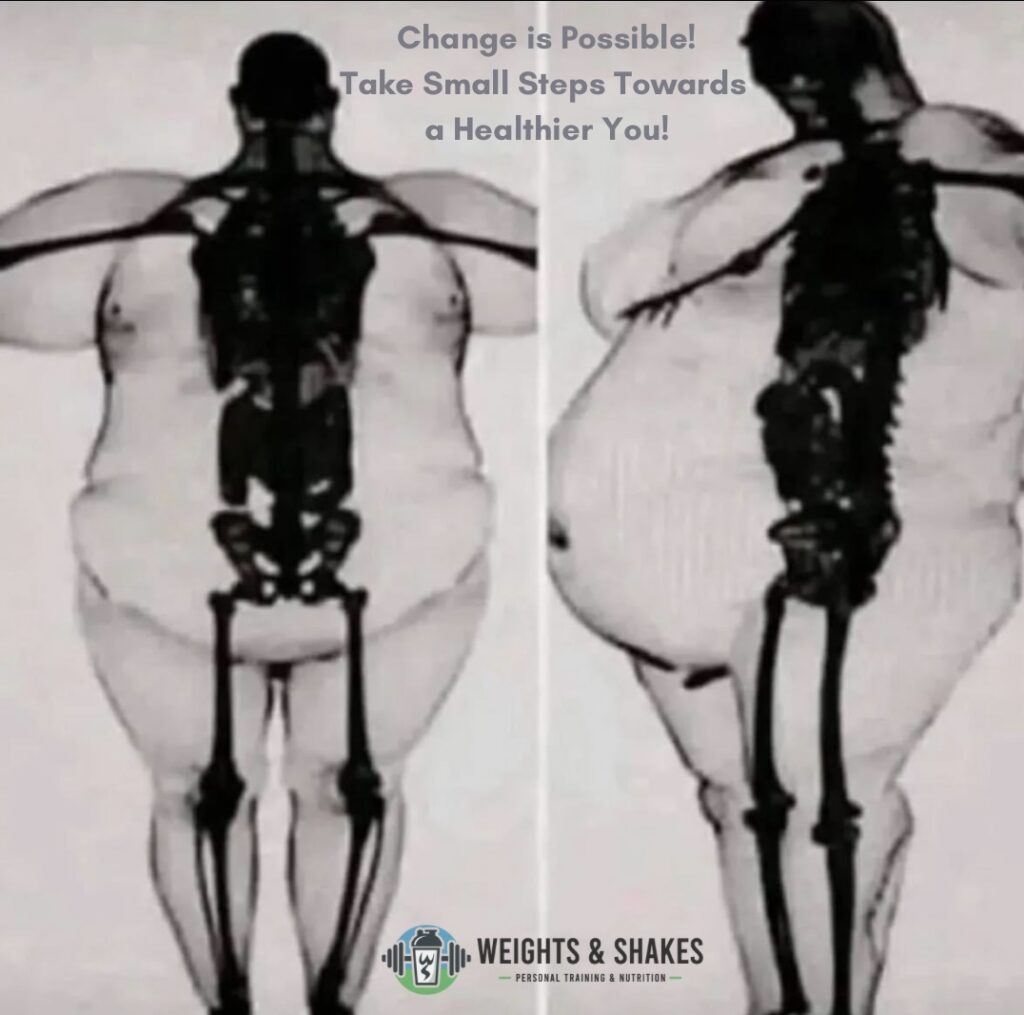Sign Up for Newsletter
Obesity is more than just carrying extra weight; it’s a condition where excess body fat significantly impacts overall health and well-being. To understand how an obese person’s body composition is made up, it’s important to break down what constitutes this composition and how the imbalance of fat contributes to various health risks. Reducing body fat, especially when extremely overweight, can feel like an overwhelming challenge, but with the right approach and mindset, it’s possible to transform your body and health for the better.
The Composition of an Obese Body
 A healthy body composition generally consists of a balance between lean mass (muscle, bone, organs, and water) and fat mass. In an obese person, the ratio shifts dramatically towards fat mass. In severe cases, body fat can account for 40% or more of total body weight. This excess fat is typically distributed in two main ways:
A healthy body composition generally consists of a balance between lean mass (muscle, bone, organs, and water) and fat mass. In an obese person, the ratio shifts dramatically towards fat mass. In severe cases, body fat can account for 40% or more of total body weight. This excess fat is typically distributed in two main ways:
- Subcutaneous Fat: This is the fat stored just under the skin, often visible in areas like the abdomen, thighs, and arms. While excess subcutaneous fat can be a cosmetic concern, it also adds extra stress on joints and mobility.
- Visceral Fat: This type of fat is stored around internal organs such as the liver, heart, and intestines. It poses significant health risks as it leads to inflammation, insulin resistance, and is linked to chronic diseases like type 2 diabetes, heart disease, and certain cancers.
Carrying excess fat not only impairs the body’s functions but also makes weight loss more challenging, as it often disrupts normal metabolic and hormonal processes.
Challenges of Losing Body Fat When Obese
- Metabolic Slowing: One of the major obstacles for people who are obese is that their metabolism can slow down, making it harder to lose weight. The body adjusts to carry the excess fat, and when attempting to reduce fat, it can go into a conservation mode, slowing down the rate at which calories are burned.
- Joint Pain and Limited Mobility: Excess weight, particularly when focused around the midsection, places a heavy burden on the joints. This can make physical activities like walking, running, or even standing for extended periods painful or difficult. As a result, getting started with regular exercise can feel daunting.
- Emotional and Psychological Barriers: The emotional toll of being obese can often be as heavy as the physical one. Feelings of shame, low self-esteem, or past experiences of failure in weight loss attempts can create mental barriers. This emotional burden often leads to a cycle of comfort eating or giving up before progress is fully realized.
- Cravings and Food Addiction: Obesity is often associated with food addictions, especially to high-sugar and high-fat foods. These processed foods activate reward centers in the brain, similar to addictive substances, making it difficult to break free from cravings and develop healthier eating habits.
Overcoming the Challenges: Tips for Reducing Body Fat
- Focus on Small, Sustainable Changes:
It can be tempting to dive into drastic diets and extreme exercise routines, but these approaches are often unsustainable and can lead to burnout. Instead, focus on making small, manageable changes over time. Start with incorporating more whole foods like vegetables, lean proteins, and complex carbohydrates into your meals. Replace sugary drinks with water or herbal teas, and focus on portion control rather than cutting out entire food groups. - Move More, Even if It’s Gentle Exercise:
Exercise is key to reducing body fat, but it’s important to start at a pace that is manageable and won’t cause injury. Walking, swimming, and cycling are excellent low-impact exercises for people with joint pain or mobility issues. Over time, as stamina and strength build, you can gradually increase the intensity and duration of your workouts. Adding resistance training is also important to help maintain or build muscle, which will increase your metabolism and aid in fat loss. - Create a Caloric Deficit Without Starving Yourself:
Fat loss occurs when you consume fewer calories than your body burns. However, extreme caloric restriction can backfire by slowing down metabolism and causing muscle loss. Instead, focus on creating a moderate caloric deficit by eating nutrient-dense, lower-calorie foods. Use tools like food diaries or apps to track your intake and stay within a healthy range. - Address Emotional Eating and Develop a Support System:
Emotional eating can sabotage fat loss efforts, especially when stress, sadness, or boredom trigger food cravings. Developing strategies to manage these emotions is essential. Mindful eating, therapy, or joining a support group can help. Surround yourself with positive influences—whether it’s friends, family, or a community—who understand and support your journey. This helps reduce feelings of isolation and encourages perseverance. - Be Patient and Celebrate Small Wins:
The process of fat loss, especially for someone who is extremely overweight, can take time. It’s crucial to be patient with yourself and not get discouraged by slow progress. Remember, each pound lost, each inch shed, and each healthier meal eaten is a step toward a healthier lifestyle. Celebrate these small victories, and don’t let temporary setbacks throw you off course. - Focus on Long-Term Health, Not Just the Scale:
Sometimes, the scale may not move as fast as you’d like, but that doesn’t mean your efforts are in vain. Focus on how your body feels: Are you more energetic? Are your clothes fitting better? Is your mood improving? These are all signs that your body is changing for the better, even if the number on the scale isn’t dropping as quickly as you’d hoped.
Persevering Through the Process
Weight loss, especially when dealing with obesity, is a marathon, not a sprint. Weights & Shakes understands that there will be ups and downs in the process and our mission is to help you stick with it. You may face setbacks, plateaus, and times of doubt, but resilience is what will carry you through. Remember why you started, whether it’s for your health, your family, or your future.
Surrounding yourself with the Weights & Shakes support system, staying consistent with your habits, and focusing on sustainable changes rather than quick fixes will be the foundation of your success. Over time, the physical and mental transformation will be worth every bit of effort, and the body you’ve always wanted—leaner, healthier, and stronger—will emerge.
Related Articles
Health & Wellness, Uncategorized




